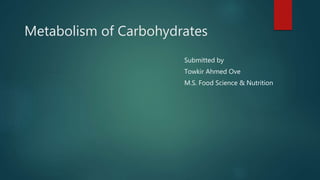
Metabolism of carbohydrates
- 1. Metabolism of Carbohydrates Submitted by Towkir Ahmed Ove M.S. Food Science & Nutrition
- 2. Metabolism: The entire spectrum of chemical reactions, occurring in the living system, are collectively referred to as metabolism. There are two categories 1. Catabolism : The degradative processes concerned with the breakdown of complex molecules to simpler ones, with a concomitant release of energy. 2. Anabolism : The biosynthetic reactions involving the formation of complex molecules from simple precursors.
- 3. Major pathways of carbohydrate metabolism The important pathways of carbohydrate metabolism are listed 1. Glycolysis (Embden-Meyerhof pathway): The oxidation of glucose to pyruvate and lactate. 2. Citric acid cycle (Krebs cycle or tricarboxylic acid cycle) : The oxidation of acetyl CoA to CO2. Krebs cycle is the final common oxidative pathway for carbohydrates, fats or amino acids, through acetyl CoA. 3. Gluconeogenesis : The synthesis of Glucose from non-carbohydrate precursors( e.g. amino acids, glycerol etc.). 4. Glycogenesis: The formation of glycogen from glucose. 5. Glycogenolysis : The breakdown of glycogen to glucose. 6. Uronic acid pathway : Glucose is converted to glucuronic acid, pentoses and, in some animals to ascorbic acid (not in man) .This Pathway is also an alternative oxidative pathway for glucose.
- 4. 7. Hexose monophosphate shunt (pentose Phosphate pathway or direct oxidative pathway): This pathway is an alternative to glycolysis and TCA cycle for the oxidation of glucose( directly to carbon dioxide and water). 8. Galactose metabolism : The pathways concerned with the conversion of galactose to glucose and the synthesis of lactose. 9. Fructose metabolism : The oxidation of fructose to pyruvate and the relation between fructose and glucose metabolism. 10. Amino sugar and mucopolysaccharides metabolism: The synthesis of amino sugars and other sugars for the formation of mucopolysaccharides and glycoproteins.
- 8. Kreb's Cycle * IDH= Isocitrate dehydrogenase α KGDH= Alpha ketoglutarate dehydrogenase MDH= malate dehydrogenase
- 9. 1. Acetyl-CoA enters the Kreb’s cycle when it is joined to oxaloacetate by citrate synthase to produce citrate. This process requires the input of water. Oxaloacetate is the final metabolite of the Kreb Cycle and it joins again to start the cycle over again,
- 10. 2. Citrate is then converted into isocitrate by the enzyme aconitase. This is accomplished by the removal and addition of water to yield an isomer
- 11. 3. Isocitrate is converted into alpha-ketogluterate by isocitrate dehydrogenase. The byproducts of which are NADH and CO2.
- 12. 4. Apha-ketogluterate is then converted into succynl-CoA by alpha- ketogluterate dehydrogenase. NADH and CO2 are once again produced.
- 13. 5. Succynl-CoA is then converted into succinate by succynl-CoA synthetase which yields one ATP per succynl-CoA.
- 14. 6. Succinate coverts into fumerate by way of the enzyme succinate dehydrogenase and [FAD] is reduced to [FADH2] which is a prosthetic group of succinate dehydrogenase. Succinate dehydrogenase is a direct part of the ETC. It is also known as electron carrier II. Fumerate is then converted to malate by hydration with the use of fumerase.
- 15. 7. Malate is converted in oxaloacetate by malate dehydrogenase the byproducts of which are NADH. Oxaloacetate is the final metabolite of the Kreb’s Cycle and it joins again to start the cycle over again to start the cycle over again.
- 16. Electron Transport Chain The final stage of aerobic respiration is the electron transport chain, which is located on the inner mitochondrial membrane. The electron transport chain is where most of the energy cells need to operate is generated. This chain is actually a series of protein complexes and electron carrier molecules within the inner membrane of eukaryotic cell mitochondria. Oxidative phosphorylation occurs over a number of distinct steps: Step 1: Generating a Proton Motive Force Step Two: ATP Synthesis via Chemiosmosis Step Three: Reduction of Oxygen
- 17. Step 1: Generating a Proton Motive Force The hydrogen carriers (NADH and FADH2) are oxidized and release high energy electrons and protons. The electrons are transferred to the electron transport chain, which consists of several trans-membrane carrier proteins. As electrons pass through the chain, they lose energy – which is used by the chain to pump protons (H+ ions) from the matrix.
- 18. The proton motive force will cause H+ ions to move down their electrochemical gradient and diffuse back into matrix. This diffusion of protons is called chemiosmosis and is facilitated by the trans-membrane enzyme ATP synthase. As the H+ ions move through ATP synthase they trigger the molecular rotation of the enzyme, synthesizing ATP. Step Two: ATP Synthesis via Chemiosmosis
- 19. In order for the electron transport chain to continue functioning, the de- energized electrons must be removed. Oxygen acts as the final electron acceptor, removing the de-energized electrons to prevent the chain from becoming blocked. Oxygen also binds with free protons in the matrix to form water – removing matrix protons maintains the hydrogen gradient Step Three: Reduction of Oxygen
- 21. Energy yield Glycolysis 2 ATP 2 ATP Kreb’s Cycle 2 NADH 8 ATP 6 NADH 2 FADH2 24 ATP Pyruvate oxidation 2 NADH 6 ATP 38 ATP NADH = 3 ATP FADH2 = 2 ATP
- 23. Gluconeogenesis
- 24. Thank You